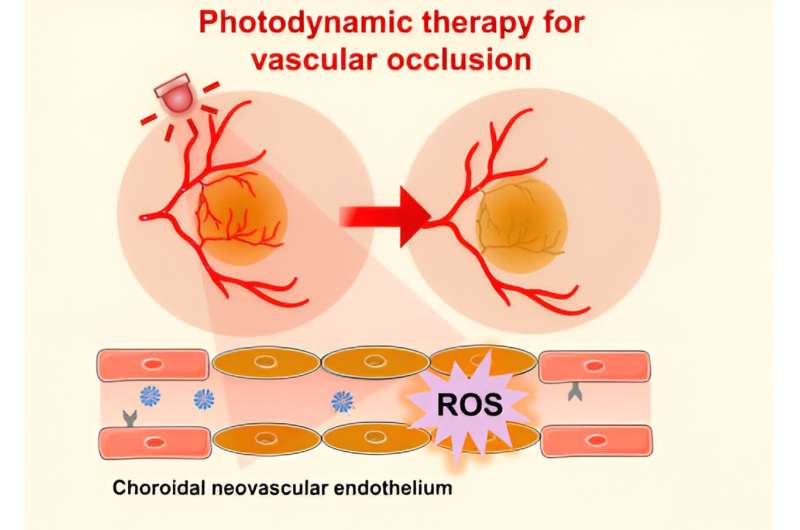
Researchers at the LKS Faculty of Medicine of the University of Hong Kong (HKUMed), and collaborators from the Zhongshan Ophthalmic Center of Sun Yat-sen University, Guangzhou, have developed a light-activatable prodrug nanomedicine for age-related macular degeneration (AMD) therapy.
Through the intravenous injection of the nanomedicine and application of light irradiation to diseased eyes, anti-angiogenic and photodynamic combination therapy can be activated, offering a minimally invasive alternative for the treatment of AMD and other ocular disorders characterized by abnormal blood vessel growth. The research has been published in Advanced Science.
According to the Hong Kong Eye Survey data published in 2019, the prevalence of early AMD among individuals aged 70 and older has reached 7.5% in Hong Kong, making AMD the second most common cause of visual impairment and blindness in the adult population of Hong Kong.
Currently, intravitreal injections of antibodies against vascular endothelial growth factor are the first-line treatment for wet AMD. However, this invasive procedure is uncomfortable for patients, and carries the risk of serious ocular complications, such as endophthalmitis and retinal detachment. Therefore, there is an urgent need for novel formulations that enable the delivery of anti-angiogenic agents into the eye without an intravitreal injection, such as intravenous injection.
Additionally, anti-angiogenic agents have limited efficacy in regressing existing neovascularization. Photodynamic therapy (PDT) offers a clinical solution by utilizing non-toxic photosensitizers activated by specific wavelengths of light to generate reactive oxygen species (ROS), which can damage and obliterate neovascularization.
PDT is widely used for the treatment of polypoidal choroidal vasculopathy, a common subtype of wet AMD in Asia. Therefore, combining anti-angiogenesis therapy with PDT may offer a more effective approach to treating wet AMD, thus helping slow down the progression of the disease and improve the vision outcome for patients.
The research team designed a novel photoactivatable prodrug nanosystem. After a single intravenous injection of the nanoparticles into a choroidal neovascularization mouse model, red-light irradiation of the mouse’s eye activated the nanoparticles to generate ROS, which not only causes the regression of abnormal neovascularization, but also triggers the release of anti-angiogenic drugs from the nanoparticles to inhibit the growth of new blood vessels. This combinational therapy demonstrated excellent therapeutic efficacy without any noticeable systemic or ocular side effects.
The study represents the first attempt at integrating a photoactivatable anti-angiogenic agent with a photosensitizer into a single nanoformulation for AMD treatment. The treatment procedure is simple and safe, as the therapeutic effect of the anti-angiogenic agent and photosensitizer in ocular lesions can be achieved through the intravenous administration of nanoparticles and light irradiation to the eye.
This pioneering research may open up new avenues for the development of minimally-invasive therapeutics for AMD and other neovascular ocular disorders. The formulation uses US FDA-approved therapeutic agents and excipients, making it promising for future clinical translation.
More information:
Shuting Xu et al, Red Light‐Triggered Anti‐Angiogenic and Photodynamic Combination Therapy of Age‐Related Macular Degeneration, Advanced Science (2023). DOI: 10.1002/advs.202301985
Journal information:Advanced Science
Provided by
The University of Hong Kong

READ MORE
Why Bioluminescence Evolved to Be Red Light, and Blue
From glow-in-the-dark squid to the terrifying stoplight loosejaw, creatures of the deep have evolved their [...]
Your Alarm Clock May Be Hazardous to Your Health
A 15th-century French calendar depicts the natural cycle of day and night. RMN-GRAND PALAIS / [...]
How Relief Wells Work
The Development Driller III drills a relief well off the coast of Louisiana in the [...]
Injectable stem cell assembly for cartilage regeneration
a) A schematic illustration of 3D TGFβ-BMSC-IHI nanoscaffold. b) The schematic illustration of gelatin-coated and [...]
Synthesizing nanosized zeolites
Credit: Juan Pablo Serrano Arenas from Pexels Zeolites are crystalline inorganic materials whose oxide-based framework [...]
Is there a thin spread adhesive for self-stick vinyl floor tiles?
Laying vinyl floor tiles is an easy do-it-yourself project. Making sure you have the right [...]
The Done-Up Bird Gets the Worm
Spotless starling chicks use a bright yellow oil to enhance the color of their mouth, [...]
Why is Mesopotamia called the cradle of civilization?
1979 excavation of Babylon, one of the ancient cities of Mesopotamia. David Hume Kennerly/Getty Images [...]